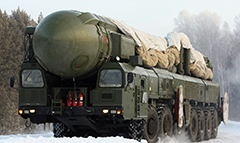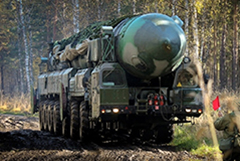Strategic Ballistic Missiles
A ballistic missile follows a ballistic trajectory to deliver one or more warheads on a predetermined target. These weapons are only guided during relatively brief periods of flight—most of their trajectory is unpowered, being governed by gravity and air resistance if in the atmosphere. Shorter range ballistic missiles stay within the Earth's atmosphere, while longer-ranged intercontinental ballistic missiles (ICBMs), are launched on a sub-orbital flight trajectory and spend most of their flight out of the atmosphere.
The earliest form of ballistic missiles dates from the 13th century with its use derived from the history of rockets. In the 14th century, the Ming Chinese navy used an early form of a ballistic cruise missile weapon called the Huo long chu shui in naval battles against enemy ships. A modern pioneer ballistic missile was the A-4, commonly known as the V-2 rocket developed by Nazi Germany in the 1930s and 1940s under the direction of Wernher von Braun. The first successful launch of a V-2 was on October 3, 1942, and it began operation on September 6, 1944 against Paris, followed by an attack on London two days later. By the end of World War II in Europe in May 1945, over 3,000 V-2s had been launched.
A total of 30 nations have deployed operational ballistic missiles. Development continues with around 100 ballistic missile flight tests in 2007 (not including those of the US), mostly by China, Iran, and the Russian Federation. In 2010, the U.S. and Russian governments signed a treaty to reduce their inventory of intercontinental ballistic missiles (ICBMs) over a seven-year period (to 2017) to 1550 units each. More details
The earliest form of ballistic missiles dates from the 13th century with its use derived from the history of rockets. In the 14th century, the Ming Chinese navy used an early form of a ballistic cruise missile weapon called the Huo long chu shui in naval battles against enemy ships. A modern pioneer ballistic missile was the A-4, commonly known as the V-2 rocket developed by Nazi Germany in the 1930s and 1940s under the direction of Wernher von Braun. The first successful launch of a V-2 was on October 3, 1942, and it began operation on September 6, 1944 against Paris, followed by an attack on London two days later. By the end of World War II in Europe in May 1945, over 3,000 V-2s had been launched.
A total of 30 nations have deployed operational ballistic missiles. Development continues with around 100 ballistic missile flight tests in 2007 (not including those of the US), mostly by China, Iran, and the Russian Federation. In 2010, the U.S. and Russian governments signed a treaty to reduce their inventory of intercontinental ballistic missiles (ICBMs) over a seven-year period (to 2017) to 1550 units each. More details
 An intercontinental ballistic missile (ICBM) is a guided ballistic missile with a minimum range of 5,500 kilometres (3,400 mi) primarily designed for nuclear weapons delivery (delivering one or more thermonuclear warheads). Similarly, conventional, chemical, and biological weapons can also be delivered with varying effectiveness, but have never been deployed on ICBMs. Most modern designs support multiple independently targetable reentry vehicles (MIRVs), allowing a single missile to carry several warheads, each of which can strike a different target.
An intercontinental ballistic missile (ICBM) is a guided ballistic missile with a minimum range of 5,500 kilometres (3,400 mi) primarily designed for nuclear weapons delivery (delivering one or more thermonuclear warheads). Similarly, conventional, chemical, and biological weapons can also be delivered with varying effectiveness, but have never been deployed on ICBMs. Most modern designs support multiple independently targetable reentry vehicles (MIRVs), allowing a single missile to carry several warheads, each of which can strike a different target.Early ICBMs had limited precision, which made them suitable for use only against the largest targets, such as cities. They were seen as a "safe" basing option, one that would keep the deterrent force close to home where it would be difficult to attack. Attacks against military targets (especially hardened ones) still demanded the use of a more precise, manned bomber. Second- and third-generation designs (such as the LGM-118 Peacekeeper) dramatically improved accuracy to the point where even the smallest point targets can be successfully attacked.
ICBMs are differentiated by having greater range and speed than other ballistic missiles: intermediate-range ballistic missiles (IRBMs), medium-range ballistic missiles (MRBMs), short-range ballistic missiles (SRBMs) and tactical ballistic missiles (TBMs). Short and medium-range ballistic missiles are known collectively as theatre ballistic missiles.
Modern ICBMs typically carry multiple independently targetable reentry vehicles (MIRVs), each of which carries a separate nuclear warhead, allowing a single missile to hit multiple targets. MIRV was an outgrowth of the rapidly shrinking size and weight of modern warheads and the Strategic Arms Limitation Treaties which imposed limitations on the number of launch vehicles (SALT I and SALT II). It has also proved to be an "easy answer" to proposed deployments of Anti-ballistic missile (ABM) systems—it is far less expensive to add more warheads to an existing missile system than to build an ABM system capable of shooting down the additional warheads; hence, most ABM system proposals have been judged to be impractical.
The first operational ABM systems were deployed in the US during the 1970s. Safeguard ABM facility was located in North Dakota and was operational from 1975 to 1976. The USSR deployed its ABM-1 Galosh system around Moscow in the 1970s, which remains in service. Israel deployed a national ABM system based on the Arrow missile in 1998, but it is mainly designed to intercept shorter-ranged theater ballistic missiles, not ICBMs. The Alaska-based United States national missile defense system attained initial operational capability in 2004. More details


